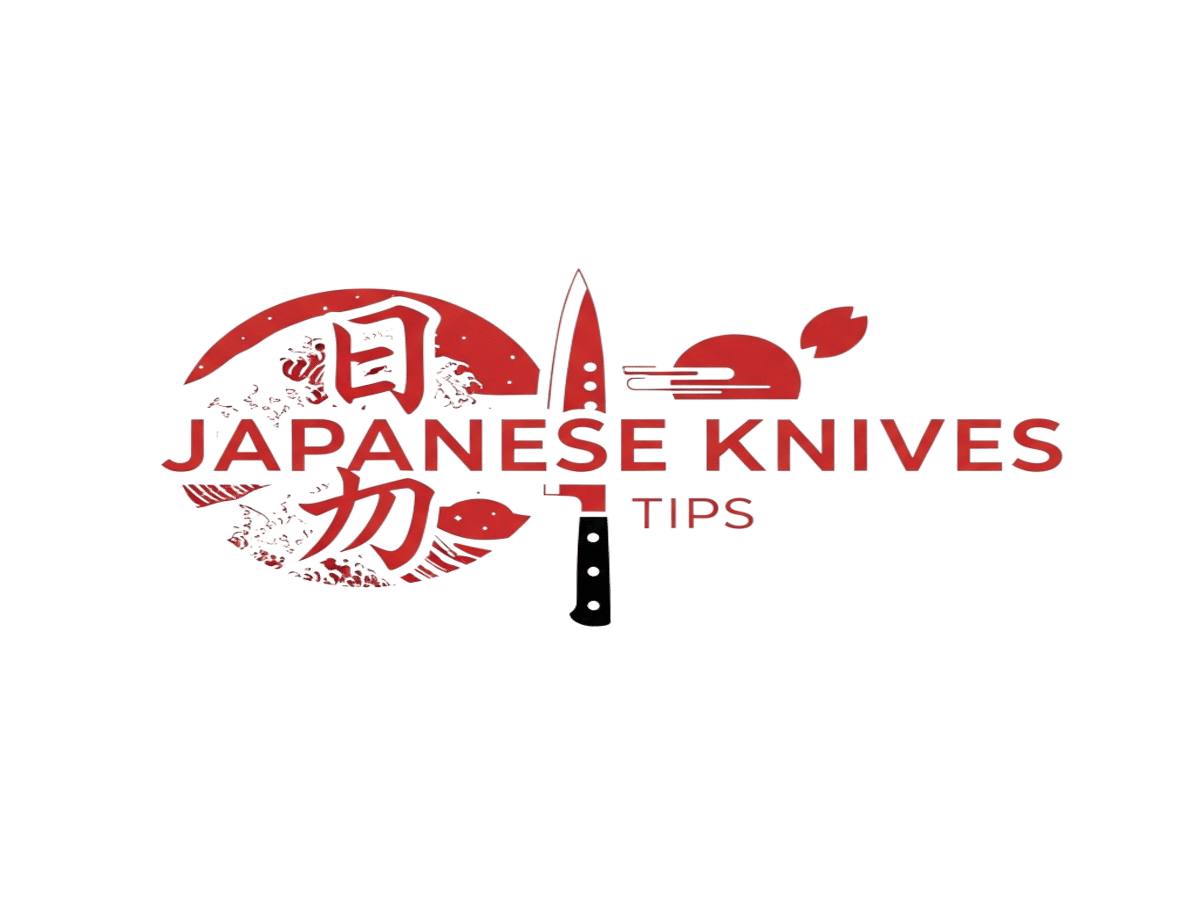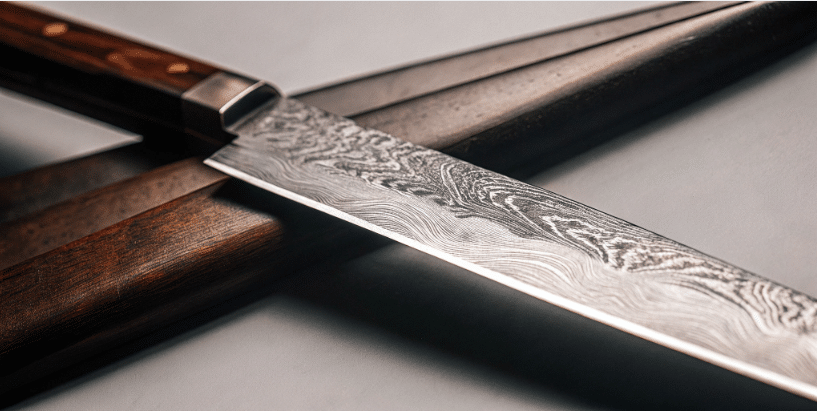If you want to cook like a pro or just make your kitchen time easier, knowing what to look for in a chef’s knife is a big deal. Chef’s knives are essential kitchen tools, valued for their versatility and available in various sizes and constructions to handle a wide range of cooking tasks. This tool is the workhorse of your kitchen, handling everything from chopping vegetables to slicing meat or filleting fish. A good chef’s knife saves time, makes cutting safer, and feels just right in your hand. Let’s talk about what makes a knife worth having and how you can pick one that suits you, keeping in mind that personal preference—such as comfort, weight, and balance—plays a key role in your choice.
- Introduction to Kitchen Knives
- Different Types of Chef’s Knives
- Blade Material and Construction
- Blade Shape and Thickness
- Handle Material and Comfort
- Balance and Weight
- Sharpness and Edge Retention
- Care and Maintenance
- Choosing the Right Size
- German Knives: What Makes Them Special?
- Japanese Knives: Precision and Sharpness
- What to Know About the Knife’s Tang
- Durable Knives: Built to Last
- Versatile Knives: One Tool, Many Tasks
- How to Hold Your Knife: The Pinch Grip
- What to Avoid When Buying a Chef’s Knife
- How to Test a Knife Before Buying
- Cost and Value: Getting the Most for Your Money
- Safety Precautions When Using Chef’s Knives
- Storing Your Knife Safely
- Regular Maintenance Tips
- Final Thoughts on Choosing Your Chef’s Knife
- FAQ
Introduction to Kitchen Knives
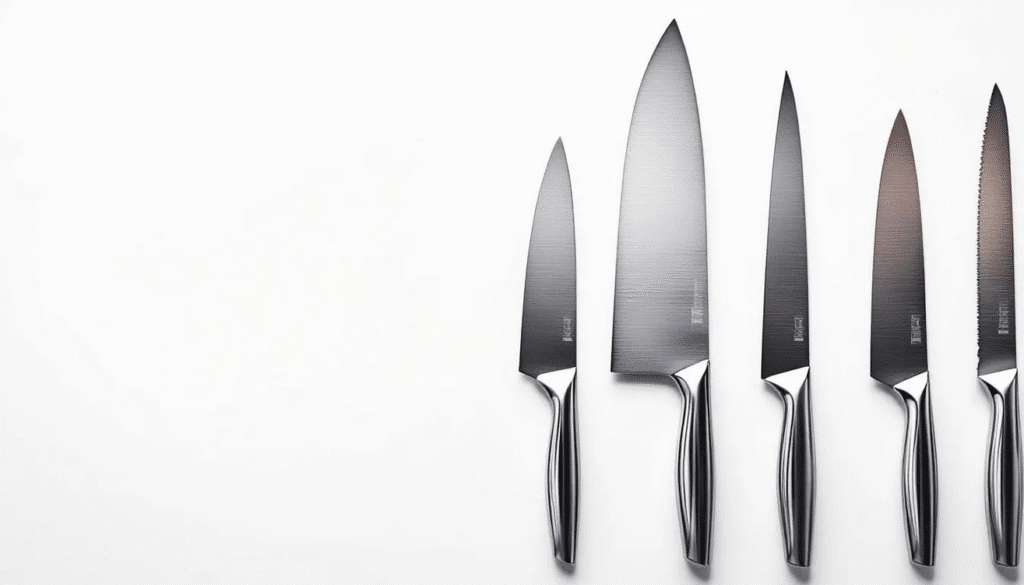
Kitchen knives are the backbone of any cook’s toolkit. You need them for quick weeknight dinners. You need them for gourmet recipes too. So many options are out there. Japanese knives are known for their precision. German knives are prized for their strength. Utility knives are versatile. It’s easy to feel overwhelmed when choosing the right tool. Here’s what matters: understanding the difference between these kitchen knives. The materials they’re made from matter too. This is key to making the best choice for your cooking style. Proper care and maintenance are essential. They keep your knives performing at their best. In this guide, we’ll break down the essentials of kitchen knives. We’ll help you decide which knife suits your needs. We’ll show you how to get the most out of this indispensable kitchen tool.
Different Types of Chef’s Knives
Chef’s knives come in many styles, but the most common are German and Japanese knives. German knives usually have thicker blades and a curved edge that’s great for rocking motions when chopping. Japanese knives tend to have thinner blades with a straighter edge, perfect for precise slicing and push-pull cuts. There’s also the santoku knife, which is a Japanese-style blade with a flatter, uniquely shaped edge. The way the santoku blade is shaped—flatter and less curved than other chef’s knives—makes it especially good for chopping and dicing with an up-and-down motion.
Besides chef’s knives, you might hear about utility knives and cleavers. Utility knives are smaller and good for detailed work, while cleavers are heavy and great for cutting through bones or tougher foods. But for most kitchen jobs, a chef’s knife is your best bet.
Blade Material and Construction
One of the first things to check is the blade material. Most knives are made from stainless steel or carbon steel. Stainless steel is tough, resists rust, and needs less care. Carbon steel can get sharper and hold an edge longer but requires more maintenance to avoid rust.
The blade’s edge is also important. Most chef’s knives are double beveled, meaning both sides of the blade are sharpened to create a sharp point. This design works well for almost any type of cutting task. Some Japanese knives have a single bevel, sharpened on only one side, which is great for specialized jobs but not as versatile. The grind of the blade, which refers to how the blade is shaped and thinned toward the edge, affects both edge retention and how easy the knife is to sharpen.
Steel hardness plays a role in how well the blade holds its edge. Harder steel stays sharp longer but can be brittle and chip if used roughly. Softer steel is more durable but needs more frequent sharpening. A good balance is key. In knife making, selecting the right steel and applying proper heat treatment are essential to achieve the ideal combination of hardness and toughness.
Blade Shape and Thickness
The shape of the blade affects how you cut. German style knives often have a curved belly, which makes chopping with a rocking motion easier. Japanese knives usually have a straighter edge, better for slicing with a push-pull motion.
Thickness matters too. Thicker blades are tougher and less likely to bend but can be heavier and harder to sharpen. Thinner blades cut more precisely but can be more fragile. Think about what you cook most and how you like to cut.
Handle Material and Comfort
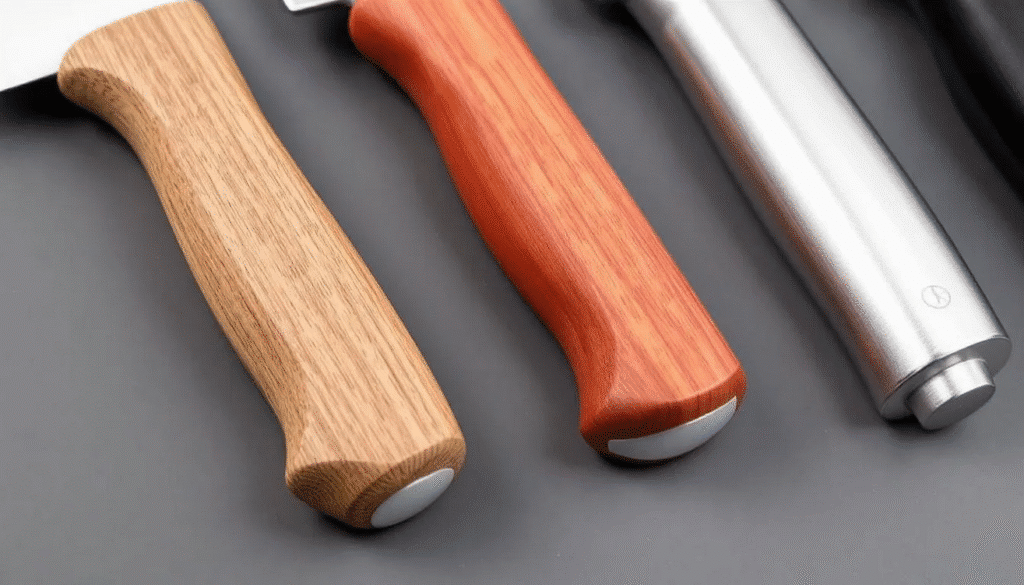
Handles come in many materials like wood, plastic, or metal. Wood handles look nice and feel warm but need more care to avoid cracking or warping. Plastic handles are durable, easy to clean, and often more affordable. Metal handles can be sleek but might get slippery if your hands are wet.
Comfort is personal. The handle should feel good in your hand and fit your grip style. If you have smaller hands, a thinner handle might work better. Larger hands might prefer a thicker grip. Knives with wider handles or more knuckle clearance are better suited for users with large hands, as they provide a more comfortable and controlled grip. Try holding different knives if you can.
Balance and Weight
Balance means how the knife feels when you hold it. A well-balanced knife feels like an extension of your hand. Some knives are blade-heavy, others handle-heavy. Neither is better; it depends on what feels right to you.
Weight is also key. Too heavy, and your arm might tire quickly. Too light, and you might press too hard, risking slips. Finding a knife that feels comfortable to hold and use for longer periods is important.
Sharpness and Edge Retention
A sharp knife is safer and easier to use. The factory edge on most knives is sharp enough to slice paper right out of the box. But all knives dull over time. How long a knife stays sharp depends on the steel hardness, blade thickness, and how you use it.
Regular honing with a honing rod keeps the edge aligned and sharp between sharpenings. When the knife gets dull, sharpening removes metal to create a new edge. The angle of the edges plays a crucial role in performance and durability—edges sharpened at 22-30 degrees are generally more durable, while finer angles under 10 degrees are suited for delicate tasks but may require more frequent maintenance. Generally, most kitchen knives are sharpened at angles between 15 and 20 degrees for a balance of sharpness and longevity. Knowing how to sharpen or having someone do it for you keeps your knife performing well. Mastering sharpening and honing takes practice, so it’s helpful to start on less valuable knives before working on your best blades.
Care and Maintenance
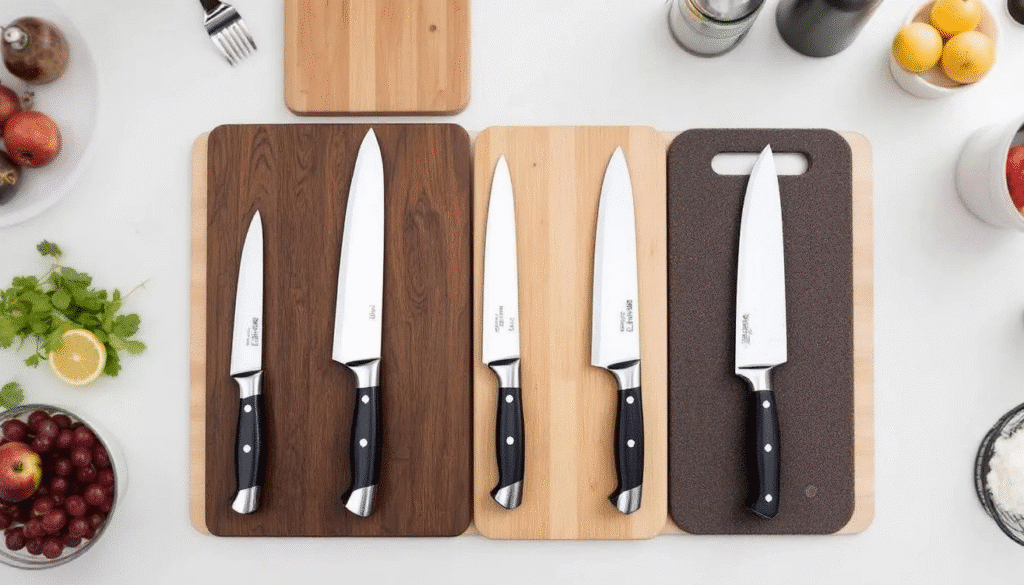
Taking care of your knife means it will last longer. Always hand wash and dry your knife right after use. Avoid putting it in the dishwasher because the blade can bump into other items and dull or chip.
Store knives safely. Don’t just toss them in a drawer where the blade can get damaged or cause injury. Use a magnetic strip, knife block, or blade guards to protect the edge. Proper storage helps protect the blade’s edge and maintain its cutting performance over time.
Use cutting boards made of wood, plastic, or rubber. Avoid cutting on glass, granite, or ceramic, which can quickly dull your knife’s edge.
Choosing the Right Size
The vast majority of home cooks prefer an 8-inch chef’s knife for its versatility.
Most home cooks do well with an 8-inch chef’s knife. It’s long enough to handle big veggies like sweet potatoes but still easy to control. If you have smaller hands or want more precision, a 6-inch knife might be better. Larger hands or bigger tasks might call for a 10-inch blade.
German Knives: What Makes Them Special?
German knives, like the well-known Wüsthof knife, are made from a single piece of high-quality German steel. They are double beveled, with a curved edge perfect for rocking cuts. The steel is hardened to be durable but not brittle, so these knives can take some rough use without chipping.
Wüsthof knives have sturdy handles fixed with rivets and a full tang, meaning the steel runs through the handle for strength and balance. They’re popular because they last a long time and work well for chopping vegetables, meat, and even tougher foods.
Many cooks choose German knife sets, such as a Wüsthof six-piece set, to have a complete collection of high-quality kitchen tools.
Japanese Knives: Precision and Sharpness
Japanese knives often have thinner, harder steel blades sharpened to a lower angle, giving a razor-sharp edge. The flatter edge suits push-pull slicing and precise cuts, like filleting fish or delicate vegetable work.
These knives can be more brittle, so they need careful use and maintenance. Their handles tend to be lighter and sometimes made from wood or composite materials. If you want a knife for detailed work and sharp slicing, a Japanese chef’s knife or gyuto is a good choice.
What to Know About the Knife’s Tang
The tang is the part of the blade that extends into the handle. Full tang knives have the steel running the entire length of the handle, which adds balance and strength. Partial tang knives have shorter steel inside the handle and may feel less sturdy.
Most quality chef’s knives have a full tang. It helps the knife feel solid and balanced, which makes cutting easier and safer.
Durable Knives: Built to Last
You want a chef’s knife that lasts. Who doesn’t? Durability matters. It comes down to materials. And craftsmanship. Japanese knives are amazing. They use high-carbon steel. This makes them sharp. Really sharp. And they stay sharp longer. They resist wear too. German knives are different. They’re built thick. Really robust. Perfect for heavy kitchen work. The steel in the edge is key. Harder steels are better. Japanese knives often use them. They don’t chip easily. They resist rust. German knives are balanced. Really well balanced. They handle repeated use. They keep their edge. Want your knife to last? You need to sharpen it regularly. Proper care is essential. A good grip helps too. A balanced blade matters. It makes the knife easier to use. Less likely to get damaged. From bad handling.
Versatile Knives: One Tool, Many Tasks
A truly great chef’s knife is amazing. It’s a multitasker in the kitchen. Can it handle almost any type of prep work? You bet. Are you chopping vegetables? Perfect. Slicing meat? No problem. Mincing herbs? Easy. The right knife makes every task easier. Why? Because it’s that good. The flat edge of a chef’s knife is perfect. It’s made for chopping and slicing. But what about a cleaver? Its curved edge is better. It tackles tougher jobs. Like breaking down bones. That’s its thing. Utility knives are different. They’re ideal for smaller work. More detailed work. Think coring fruit. Think trimming fat. They handle it all. How you grip your knife matters. Like using a pinch grip on a Japanese blade. Does it give you more control? Yes. More precision too. Perfect for delicate slicing. But what about heavier tasks? A thicker German blade is your friend. It offers the power you need. The leverage too. When choosing a knife, think smart. What types of food do you prepare most often? That’s your answer right there. Select a blade that can handle it. A wide range of kitchen tasks. With ease. With confidence. That’s what you want.
How to Hold Your Knife: The Pinch Grip
A pinch grip means holding the blade between your thumb and the side of your index finger, just above the handle. The rest of your fingers wrap around the handle. This grip gives you better control and precision.
It might feel awkward at first, but it’s the grip most chefs use. It also helps you keep your fingers safe by guiding the knife smoothly.
What to Avoid When Buying a Chef’s Knife
Watch out for knives with very thin, brittle blades that chip easily. Also, avoid knives that feel unbalanced or have handles that don’t fit your hand well.
Be careful with knives that come with a full bolster, the thick metal part between blade and handle. While it adds strength, it can make sharpening harder because you can’t sharpen the entire edge easily.
Also, don’t buy knives that come in cheap sets with dull blades. It’s better to invest in one good-quality chef’s knife than a whole drawer full of dull, poorly made knives.
How to Test a Knife Before Buying
If possible, hold the knife and see how it feels. Check the balance by resting the knife on your index finger near where the blade meets the handle. It should balance there without tipping.
Try slicing something like a tomato or onion to feel the sharpness and control. Look for a blade that cuts smoothly without needing extra pressure.
Cost and Value: Getting the Most for Your Money
Kitchen knife prices vary widely. But here’s the thing. Investing in a quality chef’s knife is smart. Really smart. Why settle for cheap? A premium knife like a Wüsthof knife costs more upfront. True. But it’s worth it. The materials are superior. The craftsmanship is better. It lasts longer. It performs better. Way better than cheap alternatives. What should you look for? The steel matters. The materials matter. Check the blade. Check the handle. Check the brand reputation. Does it have a good name? A well-made knife is your daily tool. You’ll reach for it every day. That makes the cost per use much lower. Much lower over time. Many quality kitchen knives come with warranties. They offer excellent customer support. That’s peace of mind. That’s smart buying. Want the best value? Choose a durable knife. Choose a well-balanced knife. Choose quality steel. This ensures you get the most from your investment. You’ll enjoy years of reliable service. Years of great cooking. The choice is yours.
Safety Precautions When Using Chef’s Knives
Safety first. Always safety first. Want to avoid cuts? Use a sturdy cutting board. Keep your knife stable. Protect those countertops. Sharp blades are key. Why? A sharp knife is safer. Much safer than a dull one. Less force needed. Less slipping. Makes sense, right? Grip that handle firm. Really firm. Curl your fingers under. Keep them safe. Keep them out of the blade’s path. Smart storage matters. Knife block works. Magnetic strip works too. Prevents accidents. Protects that edge. Know your surroundings. Always know. Others in the kitchen? Be extra careful. Never leave knives out. Kids can’t reach them. Ever. Follow these tips. Simple tips. Enjoy your chef’s knife. Get that precision. Feel that power. But minimize risk. Always minimize risk.
Storing Your Knife Safely
Keep your knife in a drawer with a blade guard or on a magnetic strip. This helps protect the knife’s edge from damage. Avoid tossing it loose in a drawer where it can get dull or cause cuts.
Using a wooden or plastic cutting board helps protect your knife’s edge. Glass or stone boards are too hard and will dull the blade quickly.
Regular Maintenance Tips
Use a honing rod before or after each use to keep the edge straight. When the knife dulls, sharpen it using a whetstone or a good sharpener. Be sure to address each side of the blade individually, working on one side and then the other side, to maintain an even and effective edge. Avoid cheap sharpeners that can damage the blade.
Clean your knife by hand with mild soap and dry it immediately. Don’t soak it in water or leave it wet.
Final Thoughts on Choosing Your Chef’s Knife
Picking the right chef’s knife is about finding the balance between sharpness, comfort, durability, and how you like to cook. Whether you go for a German knife like a Wüsthof or a Japanese style, the best knife is one that feels good in your hand and does the job well.
Keep your knife sharp, clean, and stored properly, and it will be a reliable kitchen partner for years. Remember, it’s not just about the brand or price but how the knife fits your cooking style and needs.
Happy chopping!
FAQ
How do I know if a chef’s knife is comfortable for me?
The best way is to hold it and see how it feels in your hand. Try the pinch grip—hold the blade between your thumb and index finger, then wrap your other fingers around the handle. If it feels good and balanced, that’s a great sign. Also, think about your hand size; smaller hands might prefer a thinner handle, while bigger hands might want something thicker.
Why should I avoid putting my knife in the dishwasher?
Dishwashers can be tough on knives. The blade can bump into other items and get dull or even chip. Plus, the heat and moisture can cause rust or damage the handle. It’s better to wash your knife by hand and dry it right away to keep it sharp and in good shape.
What’s the difference between German and Japanese chef’s knives?
German knives usually have thicker blades with a curved edge, great for rocking when chopping. Japanese knives tend to be thinner with a straighter edge, which works well for precise slicing and push-pull cuts. German knives are often tougher, while Japanese knives can be sharper but need more careful handling.
What sharpening angle should I use for different kitchen tools?
For most kitchen knives, a sharpening angle between 15 and 20 degrees is ideal for a sharp edge. However, heavy-duty tools like a cleaver or an axe benefit from a sharpening angle greater than 30 degrees. This larger angle increases durability and helps these tools withstand the force needed for tougher cutting tasks.
